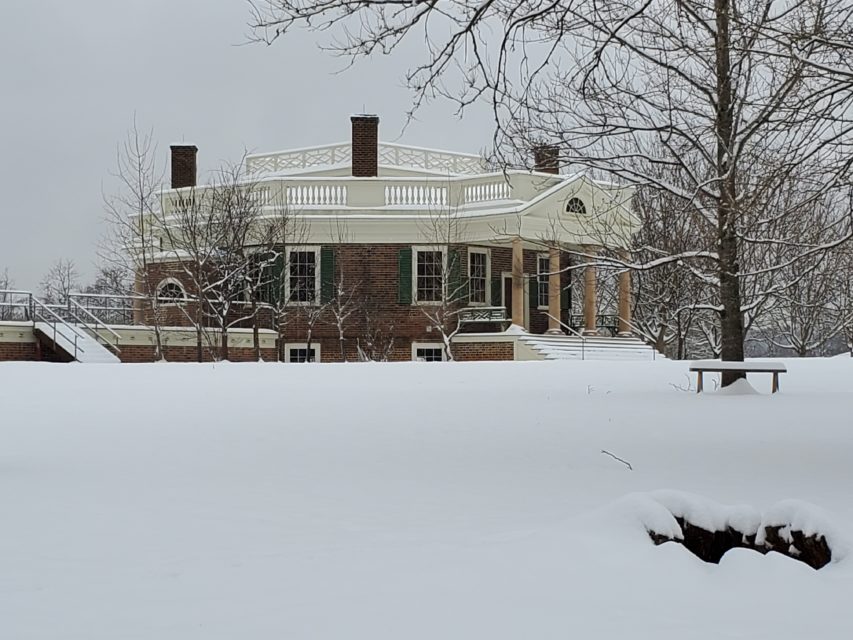Restoration Blog
Experiencing Old Places
by Travis McDonald, Director of Architectural Restoration
Recently it was my pleasure to give Thompson Mayes a tour of Poplar Forest. Mayes is a vice president and senior counsel at the National Trust for Historic Preservation and was in Lynchburg to deliver a public lecture at Randolph College.
Mayes was particularly interested in the restoration of Poplar Forest, not only because he had only seen it many years ago, but because he has been thinking a great deal about old places. In fact, his lecture was entitled “Why Old Places Matter: How Historic Places Affect Our Identity and Well-Being.” That is also the title of his published book that answers his primary question in fourteen thoughtful chapters. These can be summarized in eight subjects: memory, identity, architecture, history, beauty, sacredness, economics and sustainability.
His initial question of why we value old places might be an obvious one but as he talked to many people and asked them to verbalize their answers, he concluded that “old places matter for more reasons than we generally assume. As such, the preservation of old places is not just something ‘nice’ to do, it provides profound material, emotional, sociological, and spiritual benefits for all.” I would recommend Mayes’s thoughtful book to all who love old places in their many different and personal ways.
Of course Poplar Forest is a special place experienced by visitors for many of the reasons discussed by Mayes. His lecture and book reminded me of an earlier article and book by B. Joseph Pine II and James H. Gilmore: The Experience Economy. These authors also try to quantify and define feelings that visitors get from historic sites—their experiences.
These authors define experiences as “memorable events, revealed overtime, that engage individuals in an inherently personal way.” They indicate that a public history site, like Poplar Forest, is a thematic venue that has been professionally “staged” to offer visitors “an engaging experience that will alter a guest’s sense of reality—for doing, learning, staying, and being…that is at the heart of establishing place.” And if we are talking about historic places, the experience that integrates time, space and matter, the very stuff reality is made of, they will succeed much better if the theme fits the character of the “stage” with a concise and unified storyline.
Poplar Forest has many stories to tell but the place itself is most important. The long, slow, painstaking process of restoration is meant to not only convey something about Thomas Jefferson’s retirement years but also to authentically recreate the spaces and details of his most intimate and special work of architecture. Architecture is a particular type of fine art that lets you inside where your senses take over. As Lewis Carbone has said about the “cues” or impressions that can be created for a visitor experience, those that affect your senses, your sights, smells, tastes, sounds and textures, are more important than the “humanistic” clues given by a tour guide.
Pine and Gilmore conclude that “the more effective that an experience engages the senses, the more memorable it will be.” That is the conscious goal of authentic architectural restoration—to engage your senses, especially if the process is part of the interpretation. Watching a craftsman make a molding by hand with antique tools makes an indelible impression. The smallest correct details of a handmade molding, of a struck lime mortar joint, or of a polished oak floor are details that can be seen and appreciated by the cognoscenti as well as by the general public. Sometimes it is the unconscious experience generated by your senses that matters even more. Your senses also record the ambient feelings of a souring cubistic room, of the bright light from triple-sash windows and a skylight, and of room proportions based on classical Roman rules.
Thomas Jefferson created a special and very personal place that mattered a great deal to him in many details great and small. It is a place, a restored “stage” if you will, to give visitors a sense of Jefferson’s experience as they visit and create their own memorable and personal experience. Thompson Mayes has nailed down many of the reasons why old places should be preserved but the most important ones might still be those we cannot readily articulate, but ones we intuitively know and feel matter to us.
